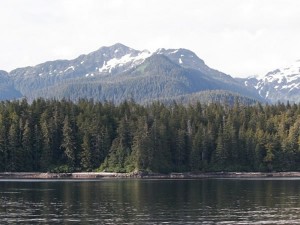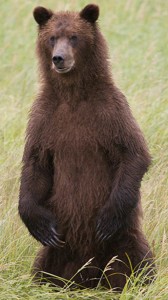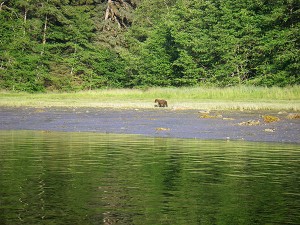Bear Witness
- Details
 In 1993, I was a second-year wilderness guide leading day trips on Admiralty Island for brown bear watching. Brown bears are the same bear as grizzlies. Many decades ago, a hunting club decided any grizzly living within approximately 100 miles of saltwater would be called a coastal brown bear, while the interior bears kept the name grizzly. For those not familiar, Admiralty Island holds claim to having the world’s highest concentration of brown bears, with a little more than one bear per square mile. This population of bears is higher than the total grizzly population of the lower 48 combined. Native Tlingit call the island “Kootsnoowoo”, which translates roughly to “fortress of the bear”. On a typical day we would fly in via floatplane from Juneau, pick up canoes at a cache, and paddle over to prime bear-watching areas. We would then spend the day taking advantage of prime sightings, photographing the bears up close and personal – often within 10-20 feet of multiple bears, sometimes dozens at a time. On this particular day I was to take two clients to an area known as Windfall Harbor. I obtained permits for this area as the rules of Admiralty Island, a National Monument, and UNESCO Biosphere Reserve, are tightly regulated. An area known as Pack Creek was the normal part of the island for our entry point, but today was different. Pack Creek was full, with another guided group and several independent observers already drawing the spaces for viewing the bears. While Pack Creek is frequented by sows – female bears – and cubs that are habituated to human presence, Windfall Harbor is known to have larger, non-human habituated boars. This presented a new facet of guiding and directing my clients for safe bear viewing. I was going to have to bring out the skills learned from years in the field, and a training class known as “bear school” I had to undertake for my guiding privileges.
In 1993, I was a second-year wilderness guide leading day trips on Admiralty Island for brown bear watching. Brown bears are the same bear as grizzlies. Many decades ago, a hunting club decided any grizzly living within approximately 100 miles of saltwater would be called a coastal brown bear, while the interior bears kept the name grizzly. For those not familiar, Admiralty Island holds claim to having the world’s highest concentration of brown bears, with a little more than one bear per square mile. This population of bears is higher than the total grizzly population of the lower 48 combined. Native Tlingit call the island “Kootsnoowoo”, which translates roughly to “fortress of the bear”. On a typical day we would fly in via floatplane from Juneau, pick up canoes at a cache, and paddle over to prime bear-watching areas. We would then spend the day taking advantage of prime sightings, photographing the bears up close and personal – often within 10-20 feet of multiple bears, sometimes dozens at a time. On this particular day I was to take two clients to an area known as Windfall Harbor. I obtained permits for this area as the rules of Admiralty Island, a National Monument, and UNESCO Biosphere Reserve, are tightly regulated. An area known as Pack Creek was the normal part of the island for our entry point, but today was different. Pack Creek was full, with another guided group and several independent observers already drawing the spaces for viewing the bears. While Pack Creek is frequented by sows – female bears – and cubs that are habituated to human presence, Windfall Harbor is known to have larger, non-human habituated boars. This presented a new facet of guiding and directing my clients for safe bear viewing. I was going to have to bring out the skills learned from years in the field, and a training class known as “bear school” I had to undertake for my guiding privileges.
 We loaded our gear into the De Havilland Otter in Juneau and flew to the canoe cache. After unloading and saying goodbye to our pilot and airplane, we watched the airborne “security-blanket” break the water’s surface and head east toward Juneau. We loaded out gear into the canoes and enjoyed a wonderful paddle over to Windfall Harbor, seeing harbor porpoise and dozens of eagles as we made our way through the calm, briny water. The weather was unseasonably hot, with temperatures approaching 85F degrees and blue skies; not exactly prime bear watching weather. Think of it this way, if you had a fur coat on, would you go out in 85F weather? Knowing that I had my work cut out for me, we began our search for the bruins. We found plenty of fresh tracks on some tidal flats, but no bears. Around lunchtime we decided to head over to the designated lunch area, set up by the rangers, where we had tied off our bear boxes containing our picnic lunch. After a jovial lunch filled with jokes, tall tales and flat out lies we decided to head back out to the tidal flats in hopes of sighting bears. My concern was mounting, however, as I know that these clients pay considerable amounts of money for the opportunity of a bear sighting and I feel obligated to do everything in my power to get make that happen. Shortly after lunch and back on the flats, one of the clients spotted what he thought were two bears in the distance, coming over a small knoll on the exposed tidal ground. Immediately my clients began assembling their gear and cameras. I focused my attention on the bears as they began coming toward us. Knowing that a bear’s eye-sight is very poor and thinking there was no chance they knew we were here, I told the clients to enjoy and get ready for the bears to get very close. As I continued to watch, the bears began to run towards us. As a guide, I had witnessed bear charges before, and knew that most of the charges are ‘false’ charges, where the bears charge to within ten or so feet of you and then stop, look at you and continue about their business. So I was alert and on guard, but not necessarily concerned as the bears started toward us. That all changed, however when the bears started bearing down at us at full tilt. Now, they were about 1000 feet away running full speed in our direction. At this point I told the clients to get to the treeline, and if possible, get up a tree. I also told them not to run. So, naturally, the clients ran. I turned towards the bears, and for the first and only time in a career that has now spanned almost 20 years, brought my shotgun into the ready position and advanced a round into the chamber. The bears were coming, I had five rounds in a shotgun and I knew I had little chance of stopping one bear with the weapon, let alone two. I remember distinctly thinking at this point, “I quit. I don’t want guide anymore.” I remember thinking about writing a letter of resignation. Still, here were the bears and I had no choice but to deal with this situation.
We loaded our gear into the De Havilland Otter in Juneau and flew to the canoe cache. After unloading and saying goodbye to our pilot and airplane, we watched the airborne “security-blanket” break the water’s surface and head east toward Juneau. We loaded out gear into the canoes and enjoyed a wonderful paddle over to Windfall Harbor, seeing harbor porpoise and dozens of eagles as we made our way through the calm, briny water. The weather was unseasonably hot, with temperatures approaching 85F degrees and blue skies; not exactly prime bear watching weather. Think of it this way, if you had a fur coat on, would you go out in 85F weather? Knowing that I had my work cut out for me, we began our search for the bruins. We found plenty of fresh tracks on some tidal flats, but no bears. Around lunchtime we decided to head over to the designated lunch area, set up by the rangers, where we had tied off our bear boxes containing our picnic lunch. After a jovial lunch filled with jokes, tall tales and flat out lies we decided to head back out to the tidal flats in hopes of sighting bears. My concern was mounting, however, as I know that these clients pay considerable amounts of money for the opportunity of a bear sighting and I feel obligated to do everything in my power to get make that happen. Shortly after lunch and back on the flats, one of the clients spotted what he thought were two bears in the distance, coming over a small knoll on the exposed tidal ground. Immediately my clients began assembling their gear and cameras. I focused my attention on the bears as they began coming toward us. Knowing that a bear’s eye-sight is very poor and thinking there was no chance they knew we were here, I told the clients to enjoy and get ready for the bears to get very close. As I continued to watch, the bears began to run towards us. As a guide, I had witnessed bear charges before, and knew that most of the charges are ‘false’ charges, where the bears charge to within ten or so feet of you and then stop, look at you and continue about their business. So I was alert and on guard, but not necessarily concerned as the bears started toward us. That all changed, however when the bears started bearing down at us at full tilt. Now, they were about 1000 feet away running full speed in our direction. At this point I told the clients to get to the treeline, and if possible, get up a tree. I also told them not to run. So, naturally, the clients ran. I turned towards the bears, and for the first and only time in a career that has now spanned almost 20 years, brought my shotgun into the ready position and advanced a round into the chamber. The bears were coming, I had five rounds in a shotgun and I knew I had little chance of stopping one bear with the weapon, let alone two. I remember distinctly thinking at this point, “I quit. I don’t want guide anymore.” I remember thinking about writing a letter of resignation. Still, here were the bears and I had no choice but to deal with this situation.
 The bears stopped about 300 feet away. They stood there for several long, drawn out minutes and I was shaking but trying to hold my ground. As time passed I remember thinking that perhaps this was bluff charging after all, and that we would be fine. Then all hell broke loose. The bears started coming at me full tilt again. My internal voice told me this was different, this was not a bluff. Against all training and better judgment, I too turned and ran. I was about 60 feet from the treeline and I went for it. I could swear I covered the distance in three steps. I made it to the trees, and was about eight feet past the tree line where I found a small dogwood tree and tried feebly to hide behind it. It provided a psychological respite even though it would do no good against the bruins. The bears were now at the tree line but for some unknown reason they would not come into the trees. They did, however, show all the classic signs of aggression - popping jaws, flipping the hump, and pounding the ground. I was horrified. I also had to find my clients. I turned and looked into the trees, and there they were, each up their own small hardwood tree, rarities for the region. What snapped me out of my fear and into anger was seeing one of the clients taking pictures of the whole affair. I was incensed by the thought of them profiting from photos of my impending, gruesome death by bruin. I barked at them to listen to me and proceeded to give instructions of what we would do when, or if, the bears left the area. We waited five or so minutes, an eternity in a situation like this, and I then had to go out onto the tidal flats to see if they were still there. I summoned all my courage and went. The bears were gone, I instructed the clients to come down. We made it to the canoes, paddled over to the rendezvous spot, and waited for the floatplane to take us back to the urban safety of Juneau. Back in Juneau we parted ways. I had paperwork to fill out and an extensive debriefing to go through, but we arranged to meet at the Red Dog Saloon that evening. When I met them later they already developed the film, this being pre-digital days. They gave me a set of the prints, which to this day are some of the most cherished pictures and possessions I own. Having a visual record of this bear charge is a gift. One of the clients then gave me three crisp, fresh, hundred-dollar bills and a business card. It turned out he was the manager of a very upscale hotel in New York City I was told to give him a call if I was ever in New York. A year later I was flying back from Turkey through New York City and called him. I ended up being put up in the hotel and had a grand time. When I was brought into his office, he proudly displayed the picture of the two of us, after the encounter. Not a bad finish truly remarkable adventure. Eric Cedric is a former mountain guide and expedition leader with 20 years of professional experience. Cedric has worked on Denali, Elbrus and a handful of Himalayan peaks. In addition, Cedric is a private pilot and professional environmental and conservation writer. Cedric splits his time each year between the Adirondack Mountains, Southern California and Costa Rica.
The bears stopped about 300 feet away. They stood there for several long, drawn out minutes and I was shaking but trying to hold my ground. As time passed I remember thinking that perhaps this was bluff charging after all, and that we would be fine. Then all hell broke loose. The bears started coming at me full tilt again. My internal voice told me this was different, this was not a bluff. Against all training and better judgment, I too turned and ran. I was about 60 feet from the treeline and I went for it. I could swear I covered the distance in three steps. I made it to the trees, and was about eight feet past the tree line where I found a small dogwood tree and tried feebly to hide behind it. It provided a psychological respite even though it would do no good against the bruins. The bears were now at the tree line but for some unknown reason they would not come into the trees. They did, however, show all the classic signs of aggression - popping jaws, flipping the hump, and pounding the ground. I was horrified. I also had to find my clients. I turned and looked into the trees, and there they were, each up their own small hardwood tree, rarities for the region. What snapped me out of my fear and into anger was seeing one of the clients taking pictures of the whole affair. I was incensed by the thought of them profiting from photos of my impending, gruesome death by bruin. I barked at them to listen to me and proceeded to give instructions of what we would do when, or if, the bears left the area. We waited five or so minutes, an eternity in a situation like this, and I then had to go out onto the tidal flats to see if they were still there. I summoned all my courage and went. The bears were gone, I instructed the clients to come down. We made it to the canoes, paddled over to the rendezvous spot, and waited for the floatplane to take us back to the urban safety of Juneau. Back in Juneau we parted ways. I had paperwork to fill out and an extensive debriefing to go through, but we arranged to meet at the Red Dog Saloon that evening. When I met them later they already developed the film, this being pre-digital days. They gave me a set of the prints, which to this day are some of the most cherished pictures and possessions I own. Having a visual record of this bear charge is a gift. One of the clients then gave me three crisp, fresh, hundred-dollar bills and a business card. It turned out he was the manager of a very upscale hotel in New York City I was told to give him a call if I was ever in New York. A year later I was flying back from Turkey through New York City and called him. I ended up being put up in the hotel and had a grand time. When I was brought into his office, he proudly displayed the picture of the two of us, after the encounter. Not a bad finish truly remarkable adventure. Eric Cedric is a former mountain guide and expedition leader with 20 years of professional experience. Cedric has worked on Denali, Elbrus and a handful of Himalayan peaks. In addition, Cedric is a private pilot and professional environmental and conservation writer. Cedric splits his time each year between the Adirondack Mountains, Southern California and Costa Rica.

